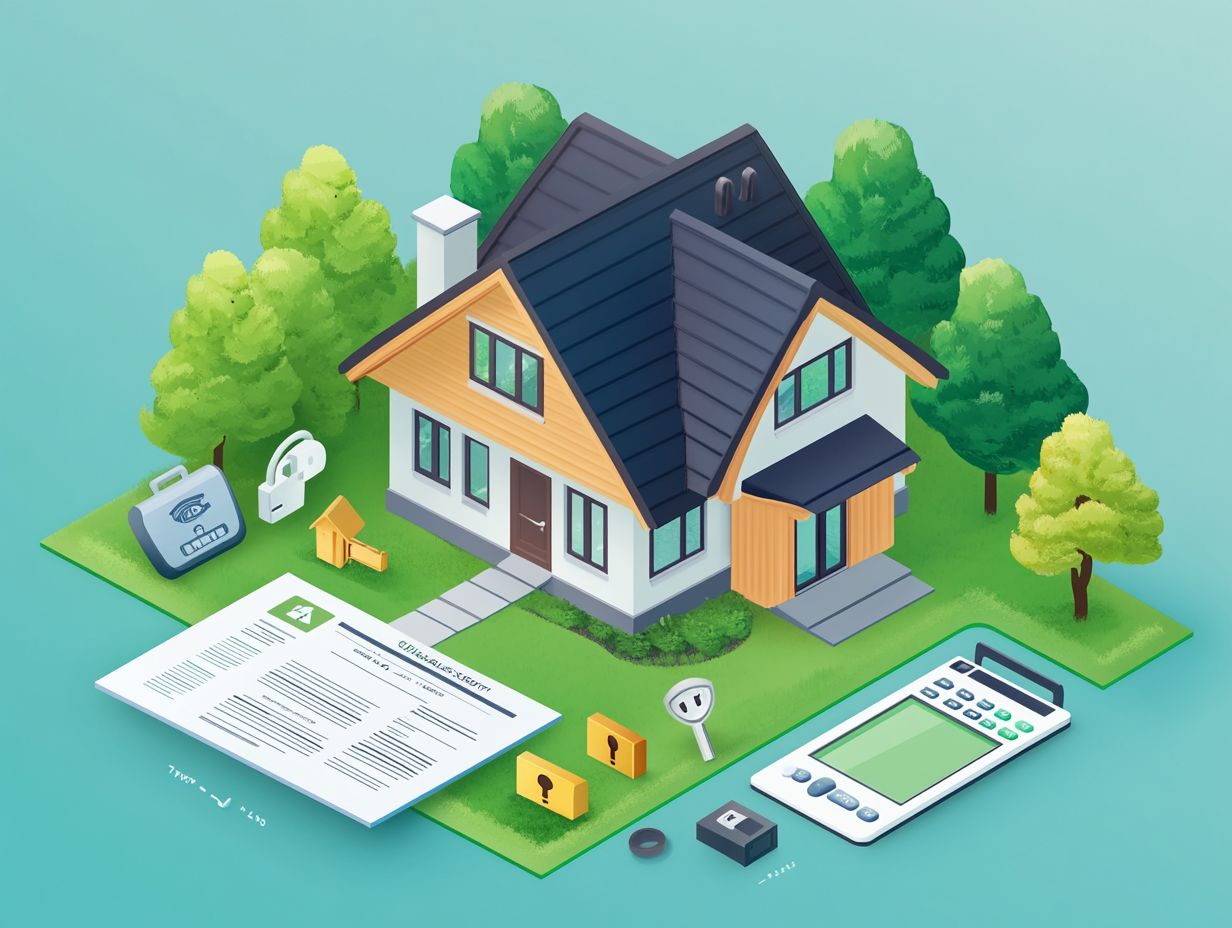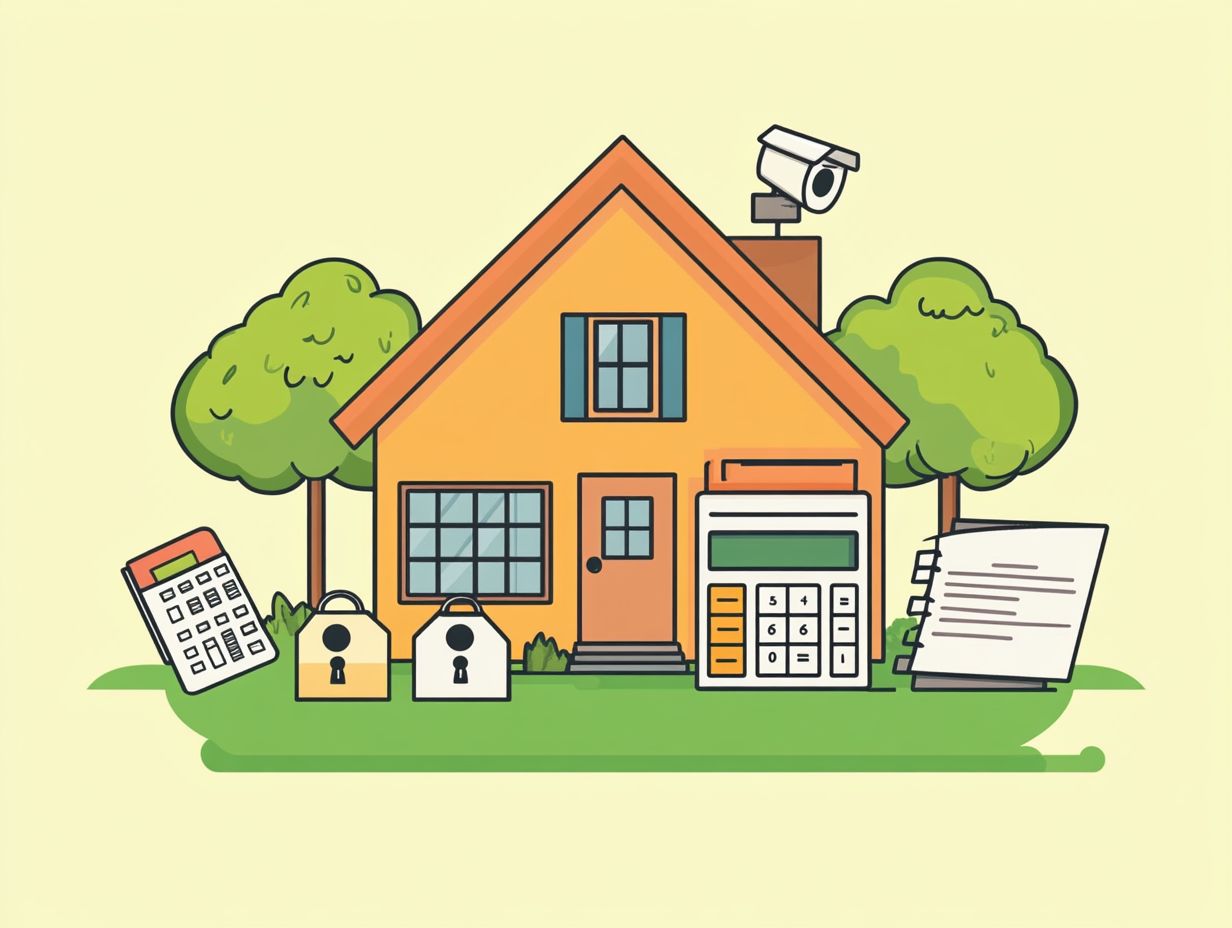7 Key Factors Influencing Home Insurance Costs
When it comes to safeguarding your most prized possession your home understanding the details of home insurance is essential.
In this article, you ll discover seven key factors that greatly affect your home insurance costs, ranging from the location and age of your property to the type of coverage you choose and your credit score.
It also offers insights on how to find ways to lower your premiums now while ensuring you have adequate protection in place.
Whether you’re a first-time homeowner or reassessing your policy, this guide will give you the info you need to make smart choices!
Contents
Key Takeaways:

The location of your home can greatly impact your insurance costs, with areas prone to natural disasters or high crime rates resulting in higher premiums.
The age and condition of your home can also affect insurance costs, as older homes may require more maintenance and be more susceptible to damage.
The type of coverage chosen, deductible amount the amount you pay out of pocket before your insurance kicks in and implementation of home security measures can all play a role in determining insurance costs.
1. Location of the Home
The location of your home is very important for shaping your home insurance policy. Various factors, such as local property crime rates, proximity to fire stations, and the presence of regional insurance providers, can influence your premiums and coverage options.
If your home is in a ZIP code with higher crime rates, you may face increased premiums due to the heightened risks of theft or vandalism.
On the flip side, neighborhoods that invest in safety features like streetlights or community watch programs create a more secure environment, which can lead to lower insurance costs.
Staying informed about these risks is essential, as they affect your insurance rates and can impact your home s overall value. By being aware of these variables, you can make savvy decisions that enhance your coverage and protect your investment.
2. Age and Condition of the Home
The age and condition of your home are vital considerations in home insurance assessments. If you own an older home, be aware that outdated plumbing or roofs may complicate your insurance.
Pay particular attention to the condition of your roof; an aging roof can lead to leaks and structural damage, making your property more susceptible to claims.
Regular maintenance issues, such as general wear and tear on various components, can further complicate your home’s insurability.
3. Type of Coverage

Choosing the right type of coverage in your home insurance policy is essential, as there are numerous options tailored to your unique needs, such as actual cash value, replacement cost, and extended coverage for valuable items.
Actual cash value policies reimburse you for the current value of your belongings, accounting for depreciation, while replacement cost policies cover the full expense of replacing damaged property, ignoring wear and tear.
Extended coverage offers additional protection, which can be particularly advantageous if you ve recently upgraded your home or acquired valuable items like artwork or jewelry.
By thoughtfully evaluating your individual requirements and potential risks, you can select policies that not only safeguard your financial investment but also provide you with peace of mind when faced with unexpected events.
Ready to review your home insurance? Let s get started!
4. Deductible Amount
The deductible amount you select for your home insurance policy can greatly impact your insurance premiums and your financial responsibility during a claim.
Choosing a higher deductible usually means lower monthly premiums, which can be appealing for homeowners looking to save. However, this strategy also carries risks, especially if an unexpected event results in a large claim.
It is essential to carefully assess your financial situation. If a higher deductible could strain your finances during a crisis, opting for a lower deductible might be wiser.
Reviewing your emergency savings, income stability, and potential out-of-pocket expenses will help you find the right approach, allowing you to enjoy peace of mind while also saving money.
5. Home Security Measures
Implementing strong home security measures can significantly reduce your home insurance premiums. Insurance providers often offer discounts for having safety features like security systems, smoke detectors, and deadbolt locks.
But why stop there? Adding smart home technologies such as surveillance cameras, motion detectors, and smart locks can improve your safety. These solutions not only deter potential intruders but also provide real-time alerts.
By demonstrating your commitment to safety through visible security measures, you contribute to community responsibility, making your neighborhood a safer place to live.
Investing in these precautions lets you enjoy substantial savings on your insurance, as a secure home reduces the likelihood of claims due to theft or damage.
6. Credit Score

Your credit score affects your home insurance costs, as many providers see credit history as an important factor in assessing risk.
A higher credit score often leads to lower premiums, indicating to insurers that you are a less risky client. Conversely, poor credit can result in higher rates or limited coverage options.
Improving your credit score can be a smart financial move that benefits both your loan applications and your insurance costs. Try these simple steps to improve your credit score:
- Pay your bills on time.
- Reduce your credit card balances.
- Regularly check your credit report for errors.
By taking these steps, you can potentially lower your insurance costs while enhancing your overall financial health.
7. Previous Claims History
Your previous claims history is crucial for insurance providers when assessing risk and determining your home insurance premiums. Frequent claims can lead to higher costs, as insurers view this pattern as a sign of future risk.
It s vital to understand how your claims record can affect your premiums. If you have few or no claims, you can save a lot.
To keep your insurance costs down, focus on minimizing claims by taking preventive actions, such as:
- Regular maintenance.
- Upgrading safety features.
- Promptly addressing potential hazards.
By being proactive, you not only improve your living environment but also position yourself favorably with insurers, paving the way for lower rates in the future.
What Is Home Insurance and Why Is It Important?
Home insurance is important financial protection for homeowners. It safeguards against losses from risks like fire, theft, natural disasters, and liability claims, giving you peace of mind.
Understanding home insurance can help you choose the right policy. Different plans cater to various homeowner needs, from basic coverage to specialized policies for risks like floods or earthquakes.
Familiarize yourself with the terms and conditions of your policy. This knowledge empowers you to make informed choices about additional coverage or endorsements to enhance your financial security.
What Are the Different Types of Home Insurance Coverage?

Home insurance offers various options to fit homeowners’ needs. You can choose from standard policies to specialized coverage for unique features.
For example, HO-1 policies provide basic coverage against specific perils like fire and theft, ideal for budget-conscious homeowners. HO-2 offers more comprehensive protection, while HO-3 is the most common, covering a wider range of risks.
Specialty policies like HO-4 and HO-6 cater specifically to renters and condo owners. If you own an older home or a mobile home, HO-5 and HO-8 ensure your needs are met.
Assess your unique situation, considering factors like location and the type of home, when selecting your insurance policy. This careful consideration helps you balance coverage and cost.
How Can a Homeowner Lower Their Insurance Costs?
You can reduce your insurance costs with smart strategies. Look for discounts for security systems, maintain a claims-free history, and make home improvements that enhance safety.
Adding features like smoke detectors and deadbolts not only makes your home safer but can also lower your premiums. Bundling home and auto insurance may lead to additional discounts, saving you more money.
Finally, take the time to compare quotes from different insurers. This allows you to find the best coverage tailored to your needs while ensuring affordability.
What Are the Common Exclusions in Home Insurance Policies?
Understanding common exclusions in home insurance policies is crucial. These exclusions can expose you to financial loss during claims, especially for floods, earthquakes, or some home-based businesses.
You might be surprised that standard policies often overlook certain disasters or liabilities, leading to unexpected expenses. For example, damages from sewer backups or normal wear and tear are typically not covered.
Review your policy details carefully to know what’s included and what’s not. Consider additional policies to cover higher-risk areas or specific needs.
This proactive approach ensures your home is well-protected against potential financial burdens.
How Can a Homeowner Ensure Adequate Coverage?
To ensure you have adequate coverage, it is essential to regularly review your insurance. This means looking over your home insurance policies to align them with your current home value, renovations, and personal needs, ensuring you have comprehensive protection.
Start by assessing any recent upgrades, like a new roof or an updated kitchen. These enhancements can significantly impact your replacement costs. By evaluating these factors, you gain a clearer understanding of your property s value and identify any areas where coverage might have been overlooked.
It is also a smart move to consult with insurance agents who can provide tailored advice based on your unique situation. They can help you navigate the complexities of your policies and suggest adjustments that reflect your latest investments.
Taking this proactive approach will protect your finances and give you peace of mind!
What Are Some Additional Factors That Can Affect Home Insurance Costs?
Several factors can influence your home insurance costs, including the condition of critical infrastructure like plumbing and electrical systems, the presence of a swimming pool, and even the breed of dog you own. Understanding these elements can help you discover the unexpected benefits of home insurance.
Maintaining a well-functioning plumbing system can lead to lower premiums, minimizing the risk of costly water damage. If you reside in an older home with outdated electrical wiring, you may face higher insurance costs due to an increased fire hazard risk.
Insurers often see swimming pools as greater liabilities, which can drive up your rates. If you own certain dog breeds that have a statistically higher incidence of bites, you might also see your premiums rise.
However, features like security systems or fire alarms can provide discounts, illustrating how various aspects of your home directly influence the overall cost of insurance.
Frequently Asked Questions
What are the 7 key factors that influence home insurance costs?
The seven key factors that can impact the cost of your home insurance are location, age of the home, size of the home, construction materials, proximity to fire protection, claims history, and coverage options.
How does the location of my home affect my insurance cost?
The location of your home plays a major role in determining your insurance premium. Homes in areas with a higher risk of natural disasters, crime, or severe weather conditions tend to have higher insurance costs compared to homes in safer areas.
Does the age of my home impact my insurance cost?
Yes, the age of your home can affect your insurance cost. Older homes may have outdated electrical systems, plumbing, and roofing, which can increase the risk of damage or accidents. As a result, insurance companies may charge higher premiums for older homes.
How does the size of my home affect my insurance cost?
The size of your home is another important factor in determining your insurance cost. Larger homes typically have a higher replacement cost, meaning it would be more expensive to rebuild in the event of a total loss. This increased risk translates to higher insurance premiums.
What role do construction materials play in home insurance costs?
The type of construction materials used in your home can impact your insurance cost. Homes made of fire-resistant materials such as brick or concrete tend to have lower insurance premiums compared to homes made of wood, which is more susceptible to fire damage.
How does my proximity to fire protection affect my insurance cost?
The distance between your home and the nearest fire station or hydrant can also impact your insurance cost. Homes located further away from fire protection may have higher premiums due to the increased risk of fire damage.
Can my claims history influence my home insurance cost?
Yes, your claims history can affect your home insurance cost. If you have a history of making multiple claims, insurance companies may consider you a higher risk and charge higher premiums to offset this risk.






